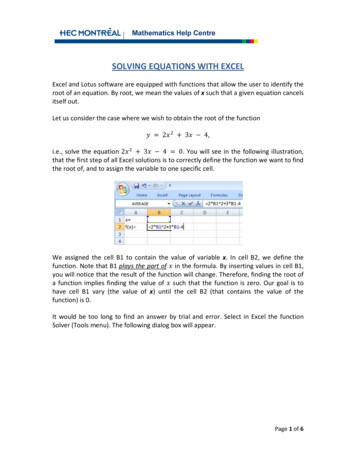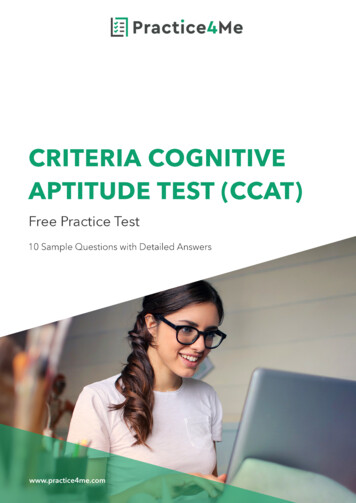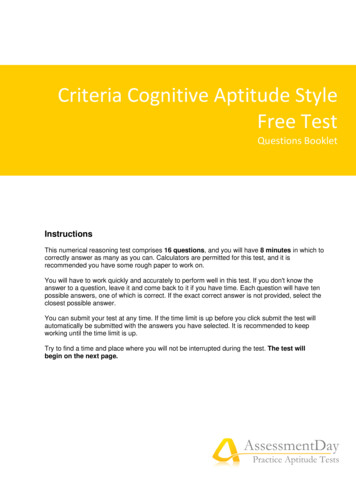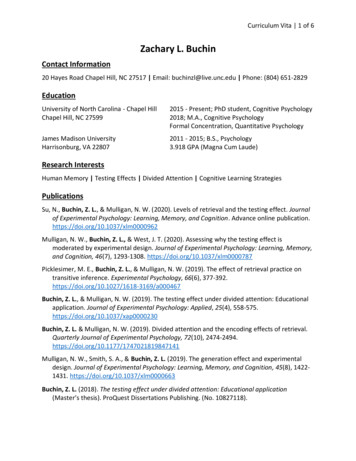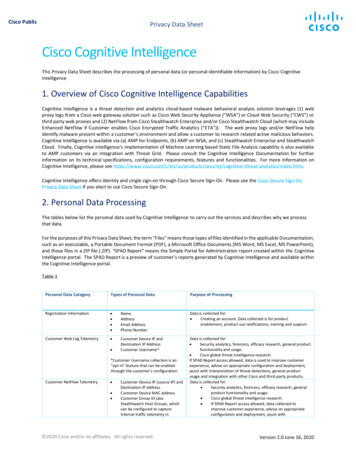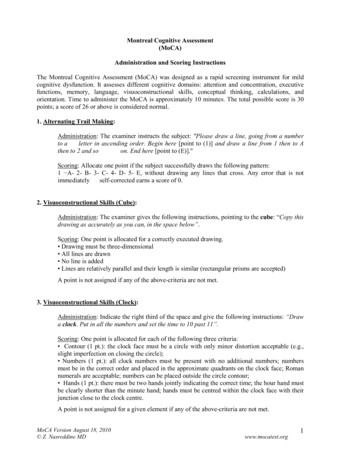
Transcription
Montreal Cognitive Assessment(MoCA)Administration and Scoring InstructionsThe Montreal Cognitive Assessment (MoCA) was designed as a rapid screening instrument for mildcognitive dysfunction. It assesses different cognitive domains: attention and concentration, executivefunctions, memory, language, visuoconstructional skills, conceptual thinking, calculations, andorientation. Time to administer the MoCA is approximately 10 minutes. The total possible score is 30points; a score of 26 or above is considered normal.1. Alternating Trail Making:Administration: The examiner instructs the subject: "Please draw a line, going from a numberto aletter in ascending order. Begin here [point to (1)] and draw a line from 1 then to Athen to 2 and soon. End here [point to (E)]."Scoring: Allocate one point if the subject successfully draws the following pattern:1 A- 2- B- 3- C- 4- D- 5- E, without drawing any lines that cross. Any error that is notimmediatelyself-corrected earns a score of 0.2. Visuoconstructional Skills (Cube):Administration: The examiner gives the following instructions, pointing to the cube: “Copy thisdrawing as accurately as you can, in the space below”.Scoring: One point is allocated for a correctly executed drawing. Drawing must be three-dimensional All lines are drawn No line is added Lines are relatively parallel and their length is similar (rectangular prisms are accepted)A point is not assigned if any of the above-criteria are not met.3. Visuoconstructional Skills (Clock):Administration: Indicate the right third of the space and give the following instructions: “Drawa clock. Put in all the numbers and set the time to 10 past 11”.Scoring: One point is allocated for each of the following three criteria: Contour (1 pt.): the clock face must be a circle with only minor distortion acceptable (e.g.,slight imperfection on closing the circle); Numbers (1 pt.): all clock numbers must be present with no additional numbers; numbersmust be in the correct order and placed in the approximate quadrants on the clock face; Romannumerals are acceptable; numbers can be placed outside the circle contour; Hands (1 pt.): there must be two hands jointly indicating the correct time; the hour hand mustbe clearly shorter than the minute hand; hands must be centred within the clock face with theirjunction close to the clock centre.A point is not assigned for a given element if any of the above-criteria are not met.MoCA Version August 18, 2010 Z. Nasreddine MD1www.mocatest.org
4. Naming:Administration: Beginning on the left, point to each figure and say: “Tell me the name of thisanimal”.Scoring: One point each is given for the following responses: (1) lion (2) rhinoceros or rhino(3) camel or dromedary.5. Memory:Administration: The examiner reads a list of 5 words at a rate of one per second, giving thefollowing instructions: “This is a memory test. I am going to read a list of words that youwill have to remember now and later on. Listen carefully. When I am through, tell meas many words as you can remember. It doesn’t matter in what order you say them”.Mark a check in the allocated space for each word the subject produces on this first trial. Whenthe subject indicates that (s)he has finished (has recalled all words), or can recall no morewords, read the list a second time with the following instructions: “I am going to read the samelist for a second time. Try to remember and tell me as many words as you can, including wordsyou said the first time.” Put a check in the allocated space for each word the subject recallsafter the second trial.At the end of the second trial, inform the subject that (s)he will be asked to recall these wordsagain by saying, “I will ask you to recall those words again at the end of the test.”Scoring: No points are given for Trials One and Two.6. Attention:Forward Digit Span: Administration: Give the following instruction: “I am going to say somenumbers and when I am through, repeat them to me exactly as I said them”. Read the fivenumber sequence at a rate of one digit per second.Backward Digit Span: Administration: Give the following instruction: “Now I am going to saysome more numbers, but when I am through you must repeat them to me in the backwardsorder.” Read the three number sequence at a rate of one digit per second.Scoring: Allocate one point for each sequence correctly repeated, (N.B.: the correct response forthe backwards trial is 2-4-7).Vigilance: Administration: The examiner reads the list of letters at a rate of one per second,after giving the following instruction: “I am going to read a sequence of letters. Every time Isay the letter A, tap your hand once. If I say a different letter, do not tap your hand”.Scoring: Give one point if there is zero to one errors (an error is a tap on a wrong letter or afailure to tap on letter A).MoCA Version August 18, 2010 Z. Nasreddine MD2www.mocatest.org
Serial 7s: Administration: The examiner gives the following instruction: “Now, I will ask you tocount by subtracting seven from 100, and then, keep subtracting seven from your answer until Itell you to stop.” Give this instruction twice if necessary.Scoring: This item is scored out of 3 points. Give no (0) points for no correct subtractions, 1point for one correction subtraction, 2 points for two-to-three correct subtractions, and 3 pointsif the participant successfully makes four or five correct subtractions. Count each correctsubtraction of 7 beginning at 100. Each subtraction is evaluated independently; that is, if theparticipant responds with an incorrect number but continues to correctly subtract 7 from it, givea point for each correct subtraction. For example, a participant may respond “92 – 85 – 78 – 71– 64” where the “92” is incorrect, but all subsequent numbers are subtracted correctly. This isone error and the item would be given a score of 3.7. Sentence repetition:Administration: The examiner gives the following instructions: “I am going to read you asentence. Repeat it after me, exactly as I say it [pause]: I only know that John is the one tohelp today.” Following the response, say: “Now I am going to read you another sentence.Repeat it after me, exactly as I say it [pause]: The cat always hid under the couch when dogswere in the room.”Scoring: Allocate 1 point for each sentence correctly repeated. Repetition must be exact. Bealert for errors that are omissions (e.g., omitting "only", "always") and substitutions/additions(e.g., "John is the one who helped today;" substituting "hides" for "hid", altering plurals, etc.).8. Verbal fluency:Administration: The examiner gives the following instruction: “Tell me as many words as youcan think of that begin with a certain letter of the alphabet that I will tell you in a moment. Youcan say any kind of word you want, except for proper nouns (like Bob or Boston), numbers, orwords that begin with the same sound but have a different suffix, for example, love, lover,loving. I will tell you to stop after one minute. Are you ready? [Pause] Now, tell me as manywords as you can think of that begin with the letter F. [time for 60 sec]. Stop.”Scoring: Allocate one point if the subject generates 11 words or more in 60 sec. Record thesubject’s response in the bottom or side margins.9. Abstraction:Administration: The examiner asks the subject to explain what each pair of words has incommon, starting with the example: “Tell me how an orange and a banana are alike”. If thesubject answers in a concrete manner, then say only one additional time: “Tell me another wayin which those items are alike”. If the subject does not give the appropriate response (fruit),say, “Yes, and they are also both fruit.” Do not give any additional instructions or clarification.After the practice trial, say: “Now, tell me how a train and a bicycle are alike”. Following theresponse, administer the second trial, saying: “Now tell me how a ruler and a watch are alike”.Do not give any additional instructions or prompts.MoCA Version August 18, 2010 Z. Nasreddine MD3www.mocatest.org
Scoring: Only the last two item pairs are scored. Give 1 point to each item pair correctlyanswered. The following responses are acceptable:Train-bicycle means of transportation, means of travelling, you take trips in both;Ruler-watch measuring instruments, used to measure.The following responses are not acceptable: Train-bicycle they have wheels; Rulerwatch they have numbers.10. Delayed recall:Administration: The examiner gives the following instruction: “I read some words to youearlier, which I asked you to remember. Tell me as many of those words as you canremember.” Make a check mark ( ) for each of the words correctly recalled spontaneouslywithout any cues, in the allocated space.Scoring: Allocate 1 point for each word recalled freely without any cues.Optional:Following the delayed free recall trial, prompt the subject with the semantic category cueprovided below for any word not recalled. Make a check mark ( ) in the allocated space if thesubject remembered the word with the help of a category or multiple-choice cue. Prompt allnon-recalled words in this manner. If the subject does not recall the word after the category cue,give him/her a multiple choice trial, using the following example instruction, “Which of thefollowing words do you think it was, NOSE, FACE, or HAND?”Use the following category and/or multiple-choice cues for each word, when appropriate:FACE:VELVET:CHURCH:DAISY:RED:category cue: part of the bodycategory cue: type of fabriccategory cue: type of buildingcategory cue: type of flowercategory cue: a colourmultiple choice: nose, face, handmultiple choice: denim, cotton, velvetmultiple choice: church, school, hospitalmultiple choice: rose, daisy, tulipmultiple choice: red, blue, greenScoring: No points are allocated for words recalled with a cue. A cue is used for clinicalinformation purposes only and can give the test interpreter additional information about thetype of memory disorder. For memory deficits due to retrieval failures, performance can beimproved with a cue. For memory deficits due to encoding failures, performance does notimprove with a cue.11. Orientation:Administration: The examiner gives the following instructions: “Tell me the date today”. If thesubject does not give a complete answer, then prompt accordingly by saying: “Tell me the[year, month, exact date, and day of the week].” Then say: “Now, tell me the name of thisplace, and which city it is in.”Scoring: Give one point for each item correctly answered. The subject must tell the exact dateand the exact place (name of hospital, clinic, office). No points are allocated if subject makesan error of one day for the day and date.TOTAL SCORE: Sum all subscores listed on the right-hand side. Add one point for anindividual who has 12 years or fewer of formal education, for a possible maximum of 30 points.A final total score of 26 and above is considered normal.MoCA Version August 18, 2010 Z. Nasreddine MD4www.mocatest.org
2. Visuoconstructional Skills (Cube): Administration : The examiner gives the following instructions, pointing to the cube: “Copy this drawing as accurately as you can, in the space below”. Scoring : One point is allocated for a correctly executed drawing. Drawing must be three-dimensional All lines are drawn No line is added
